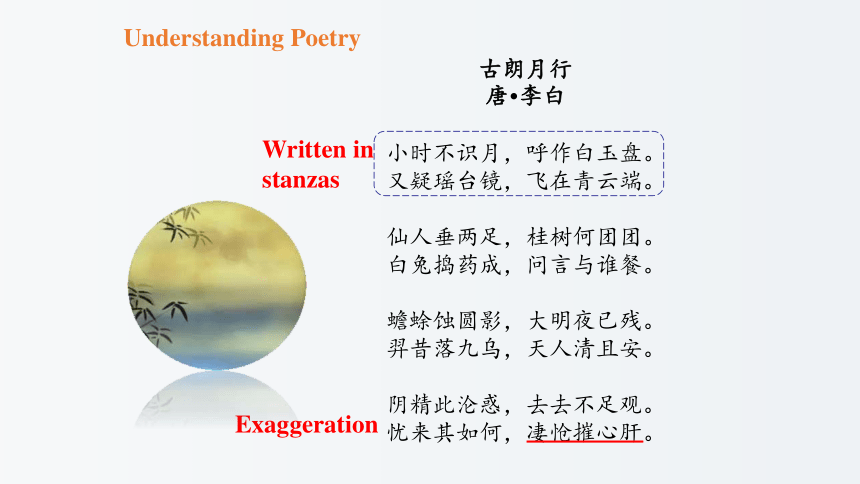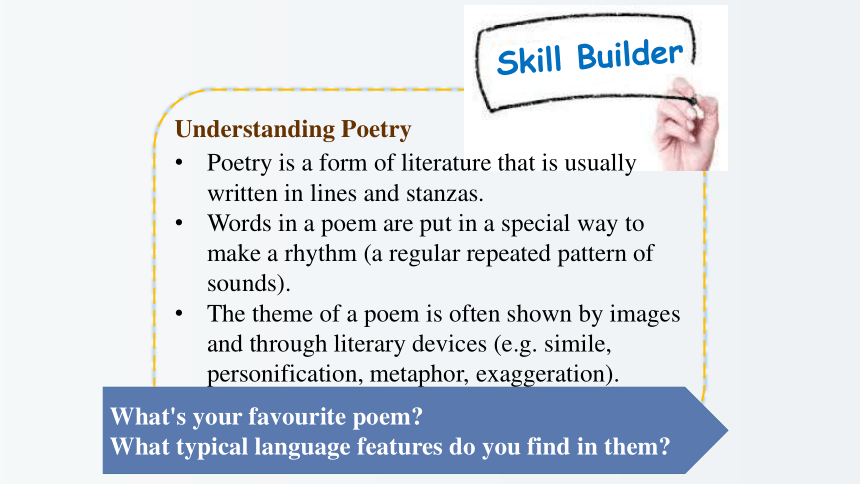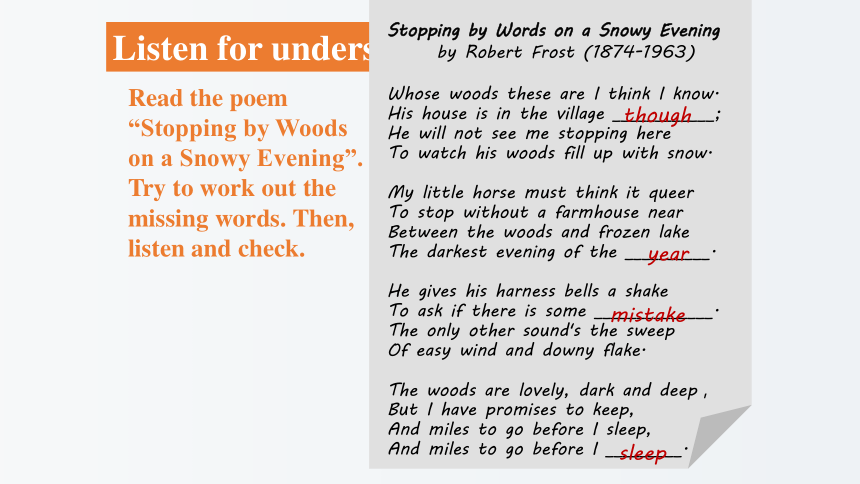北师大版(2019)选择性必修第三册Unit 8 Literature Lesson 2 Poetry 课件 (共24张PPT)
文档属性
| 名称 | 北师大版(2019)选择性必修第三册Unit 8 Literature Lesson 2 Poetry 课件 (共24张PPT) |

|
|
| 格式 | pptx | ||
| 文件大小 | 1.6MB | ||
| 资源类型 | 教案 | ||
| 版本资源 | 北师大版(2019) | ||
| 科目 | 英语 | ||
| 更新时间 | 2023-08-18 21:24:08 | ||
图片预览









文档简介
(共24张PPT)
新北师大版高中英语选择性必修三Unit8 Literature
Lesson2 Poetry
What’s your favorite poem
Can you guess the name of the poem below
A Tranquil Night
Before my bed a frost of light,
Is it hoarfrost upon the ground
Eyes raised, I see the moon so bright;
Head bent, in homesickness,
I am drowned.
Activate and share
Skill Builder
Understanding Poetry
Poetry is a form of literature that is usually written in lines and stanzas (诗节).
Words in a poem are put in a special way to make a rhythm (a regular repeated pattern of sounds).
The theme of a poem is often shown by images and through literary devices (e.g. simile, personification, metaphor, exaggeration).
What typical language features do you often find in poems
In winter In spring In summer In autumn
Watch us go, My shoes are wet. By the sea, Trees are brown,
Making footprints See how deep Sandy footprints I kick the leaves
In the snow. The puddles get. Made by me. All over town.
line 诗行
rhyme 押韵词
verse/stanza 诗节
Footprints
押/ /音
押/e/音
押/i:/音
押/a n/音
诗的一节,由排列成单元的一组诗行构成
诗的一行
句末单词最后一个音节的发音相似或相同
Let’s read a simple poem and learn the basics of poetry.
Read the following poem aloud.
Do you like this poem, why
小时不识月,呼作白玉盘。
又疑瑶台镜,飞在青云端。
仙人垂两足,桂树何团团。
白兔捣药成,问言与谁餐。
蟾蜍蚀圆影,大明夜已残。
羿昔落九乌,天人清且安。
阴精此沦惑,去去不足观。
忧来其如何,凄怆摧心肝。
古朗月行
唐 李白
Dreams
by Langston Hughes
Hold fast to dreams
For if dreams die
Life is a broken-winged bird
That cannot fly.
Hold fast to dreams
For when dreams go
Life is a barren field
Frozen with snow.
Understanding Poetry
Personification
Rhythm
Metaphor
古朗月行
唐 李白
小时不识月,呼作白玉盘。
又疑瑶台镜,飞在青云端。
仙人垂两足,桂树何团团。
白兔捣药成,问言与谁餐。
蟾蜍蚀圆影,大明夜已残。
羿昔落九乌,天人清且安。
阴精此沦惑,去去不足观。
忧来其如何,凄怆摧心肝。
Understanding Poetry
Written in stanzas
Exaggeration
Skill Builder
Poetry is a form of literature that is usually written in lines and stanzas.
Words in a poem are put in a special way to make a rhythm (a regular repeated pattern of sounds).
The theme of a poem is often shown by images and through literary devices (e.g. simile, personification, metaphor, exaggeration).
Understanding Poetry
What's your favourite poem
What typical language features do you find in them
Listen for understanding
Read the poem “Stopping by Woods on a Snowy Evening”. Try to work out the missing words. Then, listen and check.
Stopping by Words on a Snowy Evening
by Robert Frost (1874-1963)
Whose woods these are I think I know.
His house is in the village ____________;
He will not see me stopping here
To watch his woods fill up with snow.
My little horse must think it queer
To stop without a farmhouse near
Between the woods and frozen lake
The darkest evening of the __________.
He gives his harness bells a shake
To ask if there is some ______________.
The only other sound's the sweep
Of easy wind and downy flake.
The woods are lovely, dark and deep,
But I have promises to keep,
And miles to go before I sleep,
And miles to go before I _________.
though
year
mistake
sleep
Listen to the poem again and answer the questions.
1. Why did the writer stop by the words
2. Why did the horse give the harness bells a shake
He wanted to watch the snow falling in the woods.
The horse was unsure why they had stopped without a barn nearby.
3. Why couldn't the writer stay longer in the woods
The writer couldn't stay because he needed to keep going on his journey and he had many more miles left to travel.
What is the effect of the repetition in the last lines of the poem
...
And miles to go before I sleep,
And miles to go before I sleep.
To show how sad the speaker feels. He cannot stop and must continue on his long journey.
Background
Robert Frost (March 26, 1874 – January 29, 1963) was an American poet. He frequently wrote about settings from rural life in New England in the early 20th century.
“Stopping by Woods on a Snowy Evening” is a poem written in 1922,
and published in 1923 in his New Hampshire volume. Imagery, personification, and repetition are prominent in the work.
Read the poem “The Daffodils” . Use the words below to fill in the rhyming words in each stanza.
The Daffodils
by William Wordsworth (1770-1850)
I wandered lonely as a cloud,
That floats on high o'er vales and hills,
When all at once I saw a __________,
A host, of golden daffodils;
Beside the lake, beneath the ___________,
Fluttering and dancing in the breeze.
Continuous as the stars that shine,
And twinkle on the milky way,
They stretched in never-ending _________,
Along the margin of a bay:
Ten thousand saw I at a glance,
Tossing their heads in sprightly ________.
line crowd trees
daffodils dance eye
gay brought
Then, listen and check.
crowd
trees
line
dance
Listen again and answer the questions.
1. How did the poet feel before he saw the daffodils How did he feel afterwards What is the poet’s mood in the poem
Before the poet saw the daffodils, he felt lonely.
Afterwards, he felt companionship from the flowers.
The poet’s mood in the poem is happy and positive.
Listen for understanding
Listen again and answer the questions.
2. What wealth did the daffodils bring to the writer
3. How is the beauty of the daffodils depicted in the
poem
The experience provided him a memory that helped him when he was alone or in a blue mood.
The poet depicts the beauty of the daffodils by describing how they look and move.
Listen for understanding
Read the poem “The Daffodils” . Use the words below to fill in the rhyming words in each stanza.
The Daffodils
by William Wordsworth (1770-1850)
The waves beside them danced; but they
Outdid the sparkling waves in glee:
A poet could not but be _________,
In such a jocund company:
I gazed—and gazed—but little thought,
What wealth the show to me had _________:
For oft, when on my couch I lie,
In vacant or in pensive mood,
They flash upon that inward _______,
Which is the bliss of solitude;
And then my heart with pleasure fills,
And dances with the __________.
line crowd trees
daffodils dance eye
gay brought
gay
brought
eye
daffodils
Then, listen and check.
Background
William Wordsworth (7 April 1770 – 23 April 1850) was an English Romantic poet who, with Samuel Taylor Coleridge, helped to launch the Romantic Age in English literature with their joint publication Lyrical Ballads (1798).
He believed that poetry should
explore the purity and beauty of nature, and the deep human emotion inspired by the natural landscape. It is one of England's most famous poems.
Read the two poems again. Underline and talk about the literary devices the two poets used to express their feelings.
Stopping by Woods on a Snowy Evening
personification (拟人)
-- He gives his harness bells a shake
alliteration (头韵法)
-- The woods are lovely, dark and deep
repetition (重复)
-- And miles to go before I sleep
Listen for understanding
The Daffodils
alliteration (头韵)
-- Beside the lake, beneath the trees
simile (明喻)
-- I wondered lonely as a cloud
personification (拟人)
-- Fluttering and dancing in the breeze
exaggeration (夸张)
-- Continuous as the stars that shine
Read the two poems again. Underline and talk about the literary devices the two poets used to express their feelings.
Stopping by Woods on a Snowy Evening
He gives his harness bells a shake ...
The woods are lovely, dark and deep, ...
And miles to go before I sleep.
personification
alliteration
repetition
Read the two poems again. Underline and talk about the literary devices the two poets used to express their feelings.
The Daffodils
Beside the lake, beneath the trees, ...
I wondered lonely as a cloud, ...
Fluttering and dancing in the breeze
Continuous as the stars that shine
alliteration
simile
personification
exaggeration
Both Robert Frost and William Wordsworth expressed their deep love and appreciation of
nature in their poems. Discuss the different ways they expressed their appreciation. Find examples.
Both Robert Frost and William
Discuss the different ways they expressed their appreciation. Find examples.
Group Work
Wordsworth expressed their deep love and appreciation of nature in their poems.
Robert Frost
William Wordsworth
He describes the whole scene of the woods on a snowy evening vividly. He used the scene as background to show what he thinks and how his thought changes after he sees the scene.
He is cheerful with recalling the beautiful sights. In the poem, on the beauty of nature, the reader is presented a vivid picture of lively daffodils. The poet uses the description of daffodils to show his philosophical thoughts.
Writing
Homework
Write a short poem, expressing your love or appreciation of something.
新北师大版高中英语选择性必修三Unit8 Literature
Lesson2 Poetry
What’s your favorite poem
Can you guess the name of the poem below
A Tranquil Night
Before my bed a frost of light,
Is it hoarfrost upon the ground
Eyes raised, I see the moon so bright;
Head bent, in homesickness,
I am drowned.
Activate and share
Skill Builder
Understanding Poetry
Poetry is a form of literature that is usually written in lines and stanzas (诗节).
Words in a poem are put in a special way to make a rhythm (a regular repeated pattern of sounds).
The theme of a poem is often shown by images and through literary devices (e.g. simile, personification, metaphor, exaggeration).
What typical language features do you often find in poems
In winter In spring In summer In autumn
Watch us go, My shoes are wet. By the sea, Trees are brown,
Making footprints See how deep Sandy footprints I kick the leaves
In the snow. The puddles get. Made by me. All over town.
line 诗行
rhyme 押韵词
verse/stanza 诗节
Footprints
押/ /音
押/e/音
押/i:/音
押/a n/音
诗的一节,由排列成单元的一组诗行构成
诗的一行
句末单词最后一个音节的发音相似或相同
Let’s read a simple poem and learn the basics of poetry.
Read the following poem aloud.
Do you like this poem, why
小时不识月,呼作白玉盘。
又疑瑶台镜,飞在青云端。
仙人垂两足,桂树何团团。
白兔捣药成,问言与谁餐。
蟾蜍蚀圆影,大明夜已残。
羿昔落九乌,天人清且安。
阴精此沦惑,去去不足观。
忧来其如何,凄怆摧心肝。
古朗月行
唐 李白
Dreams
by Langston Hughes
Hold fast to dreams
For if dreams die
Life is a broken-winged bird
That cannot fly.
Hold fast to dreams
For when dreams go
Life is a barren field
Frozen with snow.
Understanding Poetry
Personification
Rhythm
Metaphor
古朗月行
唐 李白
小时不识月,呼作白玉盘。
又疑瑶台镜,飞在青云端。
仙人垂两足,桂树何团团。
白兔捣药成,问言与谁餐。
蟾蜍蚀圆影,大明夜已残。
羿昔落九乌,天人清且安。
阴精此沦惑,去去不足观。
忧来其如何,凄怆摧心肝。
Understanding Poetry
Written in stanzas
Exaggeration
Skill Builder
Poetry is a form of literature that is usually written in lines and stanzas.
Words in a poem are put in a special way to make a rhythm (a regular repeated pattern of sounds).
The theme of a poem is often shown by images and through literary devices (e.g. simile, personification, metaphor, exaggeration).
Understanding Poetry
What's your favourite poem
What typical language features do you find in them
Listen for understanding
Read the poem “Stopping by Woods on a Snowy Evening”. Try to work out the missing words. Then, listen and check.
Stopping by Words on a Snowy Evening
by Robert Frost (1874-1963)
Whose woods these are I think I know.
His house is in the village ____________;
He will not see me stopping here
To watch his woods fill up with snow.
My little horse must think it queer
To stop without a farmhouse near
Between the woods and frozen lake
The darkest evening of the __________.
He gives his harness bells a shake
To ask if there is some ______________.
The only other sound's the sweep
Of easy wind and downy flake.
The woods are lovely, dark and deep,
But I have promises to keep,
And miles to go before I sleep,
And miles to go before I _________.
though
year
mistake
sleep
Listen to the poem again and answer the questions.
1. Why did the writer stop by the words
2. Why did the horse give the harness bells a shake
He wanted to watch the snow falling in the woods.
The horse was unsure why they had stopped without a barn nearby.
3. Why couldn't the writer stay longer in the woods
The writer couldn't stay because he needed to keep going on his journey and he had many more miles left to travel.
What is the effect of the repetition in the last lines of the poem
...
And miles to go before I sleep,
And miles to go before I sleep.
To show how sad the speaker feels. He cannot stop and must continue on his long journey.
Background
Robert Frost (March 26, 1874 – January 29, 1963) was an American poet. He frequently wrote about settings from rural life in New England in the early 20th century.
“Stopping by Woods on a Snowy Evening” is a poem written in 1922,
and published in 1923 in his New Hampshire volume. Imagery, personification, and repetition are prominent in the work.
Read the poem “The Daffodils” . Use the words below to fill in the rhyming words in each stanza.
The Daffodils
by William Wordsworth (1770-1850)
I wandered lonely as a cloud,
That floats on high o'er vales and hills,
When all at once I saw a __________,
A host, of golden daffodils;
Beside the lake, beneath the ___________,
Fluttering and dancing in the breeze.
Continuous as the stars that shine,
And twinkle on the milky way,
They stretched in never-ending _________,
Along the margin of a bay:
Ten thousand saw I at a glance,
Tossing their heads in sprightly ________.
line crowd trees
daffodils dance eye
gay brought
Then, listen and check.
crowd
trees
line
dance
Listen again and answer the questions.
1. How did the poet feel before he saw the daffodils How did he feel afterwards What is the poet’s mood in the poem
Before the poet saw the daffodils, he felt lonely.
Afterwards, he felt companionship from the flowers.
The poet’s mood in the poem is happy and positive.
Listen for understanding
Listen again and answer the questions.
2. What wealth did the daffodils bring to the writer
3. How is the beauty of the daffodils depicted in the
poem
The experience provided him a memory that helped him when he was alone or in a blue mood.
The poet depicts the beauty of the daffodils by describing how they look and move.
Listen for understanding
Read the poem “The Daffodils” . Use the words below to fill in the rhyming words in each stanza.
The Daffodils
by William Wordsworth (1770-1850)
The waves beside them danced; but they
Outdid the sparkling waves in glee:
A poet could not but be _________,
In such a jocund company:
I gazed—and gazed—but little thought,
What wealth the show to me had _________:
For oft, when on my couch I lie,
In vacant or in pensive mood,
They flash upon that inward _______,
Which is the bliss of solitude;
And then my heart with pleasure fills,
And dances with the __________.
line crowd trees
daffodils dance eye
gay brought
gay
brought
eye
daffodils
Then, listen and check.
Background
William Wordsworth (7 April 1770 – 23 April 1850) was an English Romantic poet who, with Samuel Taylor Coleridge, helped to launch the Romantic Age in English literature with their joint publication Lyrical Ballads (1798).
He believed that poetry should
explore the purity and beauty of nature, and the deep human emotion inspired by the natural landscape. It is one of England's most famous poems.
Read the two poems again. Underline and talk about the literary devices the two poets used to express their feelings.
Stopping by Woods on a Snowy Evening
personification (拟人)
-- He gives his harness bells a shake
alliteration (头韵法)
-- The woods are lovely, dark and deep
repetition (重复)
-- And miles to go before I sleep
Listen for understanding
The Daffodils
alliteration (头韵)
-- Beside the lake, beneath the trees
simile (明喻)
-- I wondered lonely as a cloud
personification (拟人)
-- Fluttering and dancing in the breeze
exaggeration (夸张)
-- Continuous as the stars that shine
Read the two poems again. Underline and talk about the literary devices the two poets used to express their feelings.
Stopping by Woods on a Snowy Evening
He gives his harness bells a shake ...
The woods are lovely, dark and deep, ...
And miles to go before I sleep.
personification
alliteration
repetition
Read the two poems again. Underline and talk about the literary devices the two poets used to express their feelings.
The Daffodils
Beside the lake, beneath the trees, ...
I wondered lonely as a cloud, ...
Fluttering and dancing in the breeze
Continuous as the stars that shine
alliteration
simile
personification
exaggeration
Both Robert Frost and William Wordsworth expressed their deep love and appreciation of
nature in their poems. Discuss the different ways they expressed their appreciation. Find examples.
Both Robert Frost and William
Discuss the different ways they expressed their appreciation. Find examples.
Group Work
Wordsworth expressed their deep love and appreciation of nature in their poems.
Robert Frost
William Wordsworth
He describes the whole scene of the woods on a snowy evening vividly. He used the scene as background to show what he thinks and how his thought changes after he sees the scene.
He is cheerful with recalling the beautiful sights. In the poem, on the beauty of nature, the reader is presented a vivid picture of lively daffodils. The poet uses the description of daffodils to show his philosophical thoughts.
Writing
Homework
Write a short poem, expressing your love or appreciation of something.
